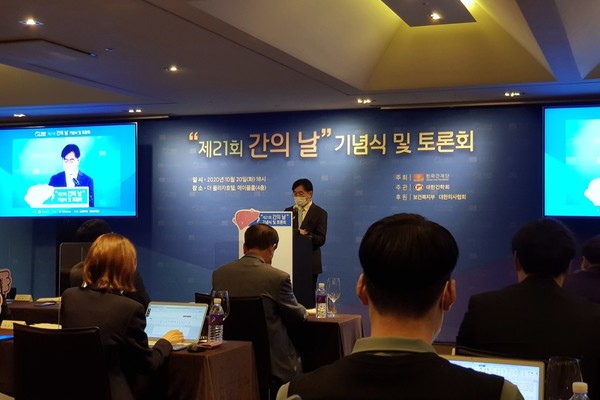“We will make sure that no patient suffers from hepatitis C viral infection after 10 years.”
Korean Liver Foundation (KLF) Chairman Seo Dong-jin and Korean Association for the Study of the Liver (KASL) Chairman Lee Han-joo said this and other remarks at a ceremony to mark Liver Day on Tuesday in Seoul.
The liver foundation and society emphasized that the World Health Organization has defined hepatitis C as a disease that can be eliminated after smallpox and calls for international attention and action.

There is no vaccine against hepatitis C due to severe mutations of the virus, but oral medications can cure 98 percent of patients.
Lee, who is also a professor at the University of Ulsan College of Medicine, said the three scientists’ winning of the 2020 Nobel Prize in medicine or physiology for their discovery of the hepatitis C virus amid the Covid-19 pandemic was an example of hope that human efforts could eradicate the virus. He called for all walks of society to take action to fight against hepatitis C.
Professor Lim Young-suk at the University of Ulsan College of Medicine, who serves as KASL’s general affairs director, spoke on the severity of viral hepatitis and countermeasures.
“The mortality risk from chronic liver diseases (cirrhosis and liver cancer) in Korea is the highest in the world,” Lim said.
As of 2014, 22.9 per 100,000 Korean men died of liver cancer per year, a number much higher than 11.4 in Hong Kong, 9.5 in Japan, 3.6 in Europe, and 3.1 in the U.S.
According to Lim, chronic hepatitis C costs 10.92 million won ($9,629) per treatment. If a patient receives treatment once, there is no additional expense.
However, if hepatitis C is neglected, compensated cirrhosis costs 3.83 million won per year, decompensated cirrhosis, 9.92 million won per year, liver cancer, 20.73 million won per year, liver transplant, 126.4 million won per year. An additional annual cost of 14.02 million won after the liver transplant, he said.
In Korea, liver disease's mortality rate is the highest among those in their 40s-60s who are most active economically, Lim went on to say. Thus, not only medical expenses but indirect social costs are very high, he said.
As hepatitis C can be cured with short-term medical care, If the nation intensively treats as many hepatitis C patients as possible, Korea can save much social cost by reducing the likelihood of transmission and preventing liver cirrhosis and liver cancer in the long term, Lim said.
KLF and KASL said they would lift the awareness of hepatitis C among the general public from the current 30 percent to 90 percent by 2030. They also vowed to raise the hepatitis C test and diagnosis rate, which remains below 10 percent now, to over 90 percent.
Due to the low awareness and diagnosis rate, four out of 10 Koreans do not receive treatment after hepatitis C infection, Lim said.
To solve this problem, KASL set the goal of improving the diagnosis and treatment rate from 60 percent to over 90 percent by 2028, he added.
Professor Jang Jae-young at Soonchunhyang University Hospital, who serves as KASL’s policy director, presented the state pilot program's progress to detect hepatitis C patients early.
Since September, KASL and the Korea Disease Control and Prevention Agency (KDCA) have been conducting free hepatitis C antibody tests for citizens born in 1964. The pilot project aims to confirm the prevalence, risk factors, and cost-effectiveness of early detection of hepatitis C in Korea.
Jang said about 30,000 to 50,000 people are estimated to have been tested so far.
Some pointed out that the examination rate was low, but some institutions could not be electronically counted, and the actual number is believed to be higher than this, he said.
KASL closes the free hepatitis C screenings on Dec. 20, and about 60,000 to 80,000 people are expected to take the test by then, Jang predicted.
The pilot project results will be used as basic data for the inclusion of the hepatitis C test in the national health check-up program and help manage hepatitis C patients and design additional research, he said.
KASL said the secondary pilot program's budget to test all 800,000 people born in 1964 next year would require an additional 3.5 billion won.
The society was discussing the target and scope of the next pilot project with KDCA, Jang said.

